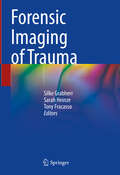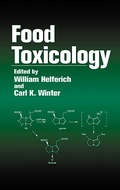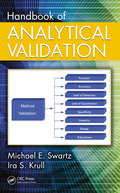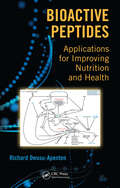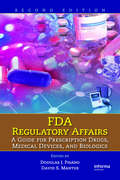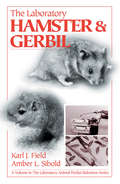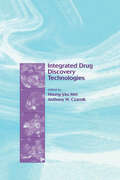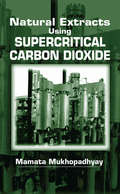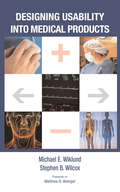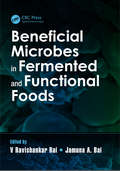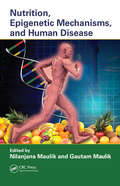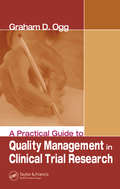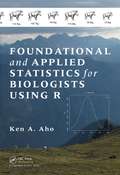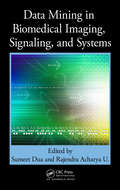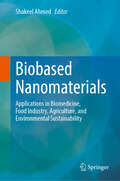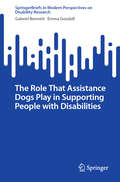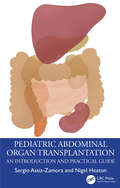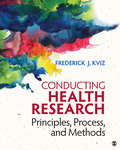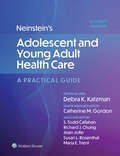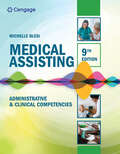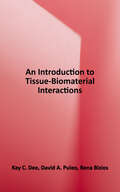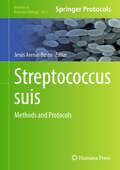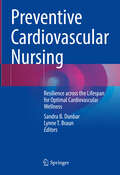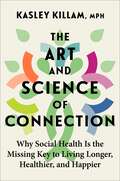- Table View
- List View
Forensic Imaging of Trauma
by Silke Grabherr Sarah Heinze Tony FracassoForensic Imaging is increasingly gaining importance in post-mortem and medico-legal investigations, particularly in cases of trauma. Indeed, the digitization of a body, serving as evidence in court, has become standard practice in many countries. To analyze forensic images effectively, one must possess expertise not only in radiological interpretation but also in understanding post-mortem changes as well as the morphology of lesions and their medico-legal implications. Neither of the two disciplines involved, Radiology and Forensic Medicine, can fully provide the necessary knowledge individually. Hence, Forensic Radiology is now recognized as a discipline that integrates both specializations. This book aims to bridge the gap between these two fields by elucidating the morphology of specific trauma-related lesions. It seeks to assist in identifying these lesions in forensic images and interpreting them accurately from a medico-legal perspective.The introductory chapter clarifies the distinctions between radiological interpretation and medico-legal imaging interpretation. It subsequently presents various techniques used in Forensic Imaging, outlining their respective advantages and limitations. Furthermore, this book is the first to comprehensively cover various types of trauma encountered in forensic medicine, including blunt trauma, sharp trauma, ballistic trauma, thermal trauma and explosions. A separate chapter is dedicated to each of them. Additionally, it addresses specific commonly observed cases such as traffic accidents, asphyxia and child abuse in dedicated chapters.Each chapter provides a concise summary of the essential medico-legal background and knowledge crucial for the final interpretation. It then outlines the appropriate radiological techniques for investigating the specific trauma and offers practical tips for image acquisition. Radiological findings are subsequently listed and illustrated in corresponding figures. Finally, the book explains the medico-legal interpretation of the observed findings and provides guidance on how to report them. This book represents a pioneering effort to amalgamate the knowledge of forensic medicine and radiology regarding the interpretation of various trauma cases. It serves as a valuable handbook for every practitioner in this field, offering practical insights from image acquisition to the ultimate interpretation of collected data.
Food Toxicology
by William Helferich Carl K. WinterNew data continually indicate that antioxidants may contribute to reductions in cancer risks and that chronic consumption of low levels of chemical carcinogens in our diet may contribute to an increased risk of developing specific types of cancers. Research also shows that in America today, the leading causes of death are cancer and heart disease.
Handbook of Analytical Validation
by Michael E. Swartz Ira S. KrullWritten for practitioners in both the drug and biotechnology industries, the Handbook of Analytical Validation carefully compiles current regulatory requirements on the validation of new or modified analytical methods. Shedding light on method validation from a practical standpoint, the handbook:Contains practical, up-to-date guidelines for analyti
Bioactive Peptides: Applications for Improving Nutrition and Health
by Richard Owusu-ApentenChronic illnesses, injury, or infections produce a decline in muscle massleading to delayed recovery, more post-treatment complications, longer hospital stays, and higher mortality rates. Therefore, ensuring adequate lean body mass is of major concern in health care. Presenting data from human studies and trials, along with recent research findings
FDA Regulatory Affairs: A Guide for Prescription Drugs, Medical Devices, and Biologics
by Douglas J. Pisano David S. MantusExamines harmonization of the US Federal Food, Drug, and Cosmetic Act with international regulations as they apply to human drug and device development, research, manufacturing, and marketing. The Second Edition focuses on the new drug approval process, cGMPs, GCPs, quality system compliance, and corresponding documentation requirements. Written in
The Laboratory Hamster and Gerbil (Laboratory Animal Pocket Reference)
by Karl J. Field Amber L. SiboldThe Laboratory Hamster and Gerbil details basic information and common procedures for individuals performing research with hamsters and gerbils. It includes duties of animal facility management, animal husbandry, regulatory compliance, and technical procedures and assists in the humane care and use of hamsters and gerbils in the laboratory. It prov
Integrated Drug Discovery Technologies
by Houng-Yau Mei Anthony W. CzarnikIntegrated Drug Discovery Technologies provides a global overview of emerging drug development technologies by presenting and integrating new techniques from the disciplines of chemistry, biology, and computational sciences. It combines integration of contemporary mechanization with strategies in drug delivery. Topics include: target identification and validation, functional genomics, microfabrication techniques, integrated proteomics technologies, high throughput screening, fluorescence correlation spectroscopy methods, and screening lead compounds in the post-genomic era.
Natural Extracts Using Supercritical Carbon Dioxide
by Mamata MukhopadhyaySynthesizing research from a wide variety of sources, this work offers a convenient guide to a clean, safe, inexpensive, non-toxic, non-polluting solvent that performs better than most conventional solvents. Natural Extracts Using Supercritical Carbon Dioxide reviews recent development in the technology and its applications to the food, flavor, fra
Designing Usability into Medical Products
by Michael E. Wiklund Stephen B. WilcoxAdvocating a user-centered approach to medical technology design, Designing Usability into Medical Products covers the essential processes and specific techniques necessary to produce safe, effective, usable, and appealing medical systems and products. Written by experts on user-centered research, design, and evaluation, the book provides a range o
Beneficial Microbes in Fermented and Functional Foods
by V Ravishankar Rai Jamuna A. BaiThis book focuses exclusively on the beneficial effects of microbes in food. The section on traditional and modern fermented foods covers the role of microbes and their diversity in fermented foods, interaction between the different microflora present in fermented food products, development of starter cultures to improve the nutritional and sensory quality of fermented foods, and factors and processes affecting the safety of various fermented foods. The second section focuses on microbes in and as functional foods: probiotics, prebiotics and synbiotics.
Nutrition, Epigenetic Mechanisms, and Human Disease
by Nilanjana Maulik Gautam MaulikAs nutrition research is shifting its focus from epidemiology and physiology to effects of nutrients at the molecular level, a uniquely tailored diet that corresponds to the demands of our genetic signature is emerging as an indispensable need. Using high-throughput genomic tools, nutrigenomics unravels the influence of micro- and macronutrients as
A Practical Guide to Quality Management in Clinical Trial Research
by Graham OggSetting up a GXP environment where none existed previously is a very daunting task. Getting staff to write down what they do for every task is a correspondingly difficult and time-consuming exercise. Examining how to maintain quality control in clinical trial research, A Practical Guide to Quality Management in Clinical Trial Research provides a co
Foundational and Applied Statistics for Biologists Using R
by Ken A. AhoFull of biological applications, exercises, and interactive graphical examples, Foundational and Applied Statistics for Biologists Using R presents comprehensive coverage of both modern analytical methods and statistical foundations. The author harnesses the inherent properties of the R environment to enable students to examine the code of complica
Data Mining in Biomedical Imaging, Signaling, and Systems
by Rajendra Acharya U Sumeet DuaData mining can help pinpoint hidden information in medical data and accurately differentiate pathological from normal data. It can help to extract hidden features from patient groups and disease states and can aid in automated decision making. Data Mining in Biomedical Imaging, Signaling, and Systems provides an in-depth examination of the biomedi
Biobased Nanomaterials: Applications in Biomedicine, Food Industry, Agriculture, and Environmental Sustainability
by Shakeel AhmedThis book comprehensively covers various aspects of biobased nanomaterials, including their types, fabrication methods, characterization techniques, and applications in different fields. The book starts with an introduction to biobased nanomaterials, highlighting their significance in various fields due to their unique properties. The first few chapters cover the different types of biobased nanomaterials, their properties, and how they are extracted from various natural sources. The methods of fabrication of biobased nanomaterials are discussed in detail, including the techniques for controlling their size, shape, and composition. It then delves into the characterization of biobased nanomaterials, discussing the different techniques used to determine their properties, including their morphology, size, structure, and composition. The subsequent chapters explore the various applications of biobased nanomaterials in different fields such as environmental applications, wound healing, tissue engineering, food industry, agriculture, sensing technology, biomedical applications, and energy storage devices. The advantages of biobased nanomaterials over traditional nanomaterials are highlighted, including their biodegradability and sustainability. The environmental concerns associated with biobased nanomaterials, as well as the health and safety concerns, are also discussed. The book concludes by looking at the prospects of biobased nanomaterials and how they can contribute to sustainable development. Overall, the book is an informative and comprehensive book that provides a thorough understanding of biobased nanomaterials and their various applications. It is a valuable resource for researchers, students, and professionals in various fields such as materials science, chemistry, biology, and environmental science. alike.
The Role That Assistance Dogs Play in Supporting People with Disabilities (SpringerBriefs in Modern Perspectives on Disability Research)
by Emma Goodall Gabriel BennettDogs have long been recognised as valuable companions for people with disabilities. In this book, readers will learn about how dogs can improve the quality of life for people with physical, sensory, and mental disabilities. Using participant and expert insights, this book explores the benefits of dogs, including how they can increase independence, improve emotional wellbeing, and enhance social connections. Whether you are a person with a disability, a caregiver, a healthcare professional, or simply interested in learning more about the remarkable ways in which dogs can support people with disabilities, this book offers a compelling and informative read
Pediatric Abdominal Organ Transplantation: An Introduction and Practical guide
by Nigel Heaton Sergio Assia-ZamoraPediatric abdominal organ transplantation is a complex procedure that requires a multidisciplinary team to ensure that outcomes are consistently excellent. This book highlights the surgical point of view of the surgical aspects of multiorgan transplantation. It is intended to deepen the knowledge of these types of transplants for medical students, nurses, doctors, and anaesthetists. This book will serve to expand the understanding of the general concepts of pediatric abdominal transplantation, focusing on the indications, surgical techniques, and complications of each type of graft for all multidisciplinary team members.
Conducting Health Research: Principles, Process, and Methods
by Frederick J. KvizConducting Health Research: Principles, Process, and Methods presents an integrated and practical introduction to the principles and strategies for planning, implementing, reporting, and assessing health sciences research. Comprehensive in its breadth and depth, with an accessible writing style, this text prepares students in public health and related fields to be adept researchers and consumers of health research. Through real-world examples and step-by-step guidance, Frederick J. Kviz provides students with the skills they need to: identify and evaluate research strengths and limitations as practitioners; to actually perform the various core aspects of research; and to choose among alternative methods when making decisions about health practice, policy, and future research needs.
Conducting Health Research: Principles, Process, and Methods
by Frederick J. KvizConducting Health Research: Principles, Process, and Methods presents an integrated and practical introduction to the principles and strategies for planning, implementing, reporting, and assessing health sciences research. Comprehensive in its breadth and depth, with an accessible writing style, this text prepares students in public health and related fields to be adept researchers and consumers of health research. Through real-world examples and step-by-step guidance, Frederick J. Kviz provides students with the skills they need to: identify and evaluate research strengths and limitations as practitioners; to actually perform the various core aspects of research; and to choose among alternative methods when making decisions about health practice, policy, and future research needs.
Neinstein's Adolescent and Young Adult Health Care: A Practical Guide
by Catherine M. Gordon S. Todd Callahan Richard J. Chung Alain Joffe Susan L. Rosenthal Marie E. TrentThe #1 choice for more than 35 years for those involved in the care of adolescents and young adults, Neinstein’s Adolescent and Young Adult Health: A Practical Guide, 7th Edition is your go-to resource for practical, authoritative guidance. The fully updated seventh edition, edited by Drs. Debra K. Katzman, Catherine M. Gordon, S. Todd Callahan, Richard J. Chung, Alain Joffe, Susan L. Rosenthal, and Maria E. Trent, offers a comprehensive view of the interdisciplinary nature of the field and is inclusive of the wide variety of health professionals who care for adolescents and young adults. This award-winning text features a full-color design, several new chapters, numerous algorithms, bulleted text throughout for quick reference at the point of care, and fresh perspectives from new editors—making it ideal for daily practice or certification examination preparation.
Medical Assisting: Administrative and Clinical Competencies
by Virginia Ferrari Michelle BlesiStrengthen your knowledge base as well as the critical skills and behaviors needed to become a successful entry-level medical assistant with Blesi's MEDICAL ASSISTING: ADMINISTRATIVE AND CLINICAL COMPETENCIES, 9E. Clear and easy to understand, this streamlined edition now includes a complete, updated section on the structure and function of body systems with current medical terminology presented in context. Updates highlight the latest information in nutrition, the Affordable Care Act (ACA), ICD-10 and electronic health records. Expanded content focuses on increasing your personal effectiveness as you study professionalism, teamwork and time management. New chapters also discuss geriatrics and mental health -- topics of growing importance. You examine the latest procedures as you increase your general, administrative and clinical competencies. MindTap digital resources help you further develop a competitive advantage as you pursue a career in medical assisting today.
An Introduction to Tissue-Biomaterial Interactions
by Rena Bizios David A. Puleo Kay C. DeeThis book acquaints an undergraduate audience with the fundamental biological processes that influence these sophisticated, cutting-edge procedures. Chapters one through three provide more detail about the molecular-level events that happen at the tissue-implant interface, while chapters four through ten explore selected material, biological, and physiological consequences of these events. The importance of the body’s wound-healing response is emphasized throughout. Specific topics covered include: Structure and properties of biomaterials - Proteins - Protein-surface interactions - Blood-biomaterial interactions - Inflammation and infection - The immune system - Biomaterial responses to implantation - Biomaterial surface engineering - Intimal hyperplasia and osseointegration as examples of tissue-biomaterial interactions The text also provides extensive coverage of the three pertinent interfaces between the body and the biomaterial, between the body and the living cells, and between the cells and the biomaterial that are critical in the development of tissue-engineered products that incorporate living cells within a biomaterial matrix. Ideal for a one-semester, biomedical engineering course, An Introduction to Tissue-Biomaterial Interactions provides a solid framework for understanding today’s and tomorrow’s implantable biomedical devices.
Streptococcus suis: Methods and Protocols (Methods in Molecular Biology #2815)
by Jesús Arenas BustoThis volume covers the classic and new techniques used to study the zoonotic pathogen Streptococcus suis. The chapters in this book cover are organized in four sections and cover topics such as techniques for cultivation, isolation, typing of S. suis biofilm formation and genetic manipulation; analysis of antibiotic resistance and transference; detection in pigs and infection models; and evaluation of economic impact and prevention. Written in the highly successful Methods in Molecular Biology series format, chapters include introductions to their respective topics, lists of the necessary materials and reagents, step-by-step, readily reproducible laboratory protocols, and tips on troubleshooting and avoiding known pitfalls. Comprehensive and thorough, Streptococcus suis: Methods and Protocols is a valuable resource for both novel and expert researchers who want to expand their knowledge of this important field.
Preventive Cardiovascular Nursing: Resilience across the Lifespan for Optimal Cardiovascular Wellness
by Sandra B. Dunbar Lynne T. BraunThis book provides a comprehensive overview of essential concepts and evidence that guide the practice of contemporary preventive cardiovascular nursing. The sections incorporate a lifespan approach to cardiovascular wellness, and provide perspectives on sources of known and emerging cardiovascular risk factors as well as the spectrum of multidimensional factors including biological, behavioral, psychological and sociocultural influences on cardiovascular wellness, risk, and the evolution of cardiovascular conditions. Unique features address: 1) building resilience across the lifespan such that optimal cardiovascular wellness can be attained within multiple contexts of health states to increase a healthy lifespan and longevity; 2) behavior change skills for risk factor reduction; 3) risk factors and risk reduction approaches with special populations defined by gender, , age and aging, heath states, and health equity issues; and 4) high level roles for cardiovascular nurses as provider - risk assessor, communicator and care provider; educator, leader, patient and health advocate. Relevant case studies are included throughout to facilitate the application of the content. This book fills a gap in that there is no other book on preventive cardiovascular nursing care and roles , and it provides support for the nurse to lead relevant interdisciplinary teams. The book will empower nurses to build knowledge and skills for cardiovascular prevention and to provide leadership for optimal cardiovascular wellness for patients and communities.
The Art and Science of Connection: Why Social Health Is the Missing Key to Living Longer, Healthier, and Happier
by Kasley KillamA groundbreaking redefinition of what it means to be healthy that introduces the need for social health—the part of wellbeing that comes from feeling connected—to truly flourish.Exercise. Eat a balanced diet. Go to therapy. Most wellness advice is focused on achieving and maintaining good physical and mental health. But Harvard-trained social scientist and pioneering social health expert Kasley Killam reveals that this approach is missing a vital component: human connection. Relationships not only make us happier, but also are critical to our overall health and longevity. Research shows that people with a strong sense of belonging are 2.6 times more likely to report good or excellent health. Perhaps even more astonishingly, people who lack social support are up to 53% more likely to die from any cause. Yet social health has been overlooked and underappreciated—until now.Just as we exercise our physical muscles, we can strengthen our social muscles. Weaving together cutting-edge science, mindset shifts, and practical wisdom, Killam offers the first methodology for how to be socially healthy. An antidote to the loneliness epidemic and an inspiring manifesto for seeing wellbeing as not only physical and mental, but also social, The Art and Science of Connection is a handbook for thriving. In this essential book, you will:Learn a simple yet powerful framework to understand, evaluate, and bolster your social health.Discover the exact strategy or habit you need, as well as research-backed tips, to cultivate and sustain meaningful connection now and throughout your life.Glean actionable insights to develop a sense of community in your neighborhood, at work, and online from a spirited group of neighbors in Paris, the CEO of a major healthcare company, and an artificially intelligent chatbot.Get an insider look at the innovative ways that doctors, teachers, entrepreneurs, architects, government leaders, and everyday people are catalyzing a movement toward a more socially healthy society.The Art and Science of Connection will transform the way you think about each interaction with a friend, family member, coworker, or neighbor, and give you the tools you need to live a more connected and healthy life—whether you are an introvert or extrovert, if you feel stretched thin, and no matter your age or background. Along the way, Killam will reveal how a university student, a newlywed, a working professional, and a retired widow overcame challenges to thrive through connection—and how you can, too.
